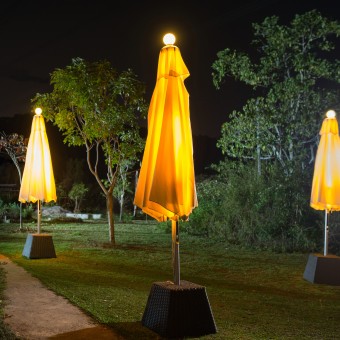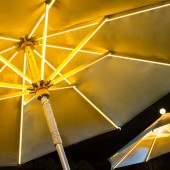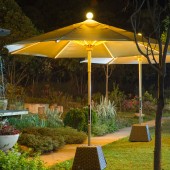
| THE AWARD |
| CATEGORIES |
| REGISTRATION |
| SUBMIT YOUR WORK |
| ENTRY INSTRUCTIONS |
| TERMS & CONDITIONS |
| PUBLICATIONS |
| DATES & FEES |
| METHODOLOGY |
| CONTACT |
| WINNERS |
| PRESS ROOM |
| GET INVOLVED |
| DESIGN PRIZE |
| DESIGN STORE |
| THE AWARD | JURY | CATEGORIES | REGISTRATION | PRESS | WINNERS | PUBLICATIONS | ENTRY INSTRUCTIONS |
Ni Led Parasol by Terry Chow |
Home > Winners > Design #33976 >Interview |
 |
|
FS: What is the main principle, idea and inspiration behind your design?
TC: Our main principle is to design something that is highly adaptable to different environments based on a classic item that everybody knows. We come up with the idea to design the NI noticing that parasol is only used during daytime. We doubt about that as we are always inspired by the concept that things mean more than what we think.
FS: What has been your main focus in designing this work? Especially what did you want to achieve?
TC: To make it all-in-one so that it can be moved to anywhere and easily plugged in. “Simple to use” is what we want to achieve.
FS: What are your future plans for this award winning design?
TC: To make it even more outstanding and further develop on its concept.
FS: How long did it take you to design this particular concept?
TC: It took us almost 4-5 years. We once thought that it would appear in the market but it didn’t. That’s why we decided to create it on our own.
FS: Why did you design this particular concept? Was this design commissioned or did you decide to pursuit an inspiration?
TC: Many people asked the same question. At the beginning it was a side project that we first tried on, as it was totally different from what our company has been working on.
FS: Is your design being produced or used by another company, or do you plan to sell or lease the production rights or do you intent to produce your work yourself?
TC: We designed and produced it.
FS: What made you design this particular type of work?
TC: We noticed what our streets, the surrounding environments are missing. Then we looked at what we have in hands and found that we were ready to do this.
FS: Where there any other designs and/or designers that helped the influence the design of your work?
TC: No.
FS: Who is the target customer for his design?
TC: It is likely to be taken as a decorative item for the luxury class or high-end customers that are interested in quality of life. But we believe that it also benefits the general public and commercial customers such as hotels, resorts and etc.
FS: What sets this design apart from other similar or resembling concepts?
TC: The overall simplicity.
FS: How did you come up with the name for this design? What does it mean?
TC: NI means “not exactly” in Spanish. Things tend to be perceived as what they appear to be, but they are actually more than that. The NI Parasol is a parasol, but it is not all of it. It is also a torch, lighting system and etc…
FS: Which design tools did you use when you were working on this project?
TC: CAD and screwdriver….
FS: What is the most unique aspect of your design?
TC: The 3-channel dimmable LED lighting.
FS: Who did you collaborate with for this design? Did you work with people with technical / specialized skills?
TC: We worked with a guy in Technology Solutions, who graduated with a B.Sc. from McMaster University and Ph.D from University of Toronto. He provided us a lot of support on lighting and PCB design.
FS: What is the role of technology in this particular design?
TC: The dimmable 3-channel lighting.
FS: Is your design influenced by data or analytical research in any way? What kind of research did you conduct for making this design?
TC: The colors of lighting did take us some time to research and test on.
FS: What are some of the challenges you faced during the design/realization of your concept?
TC: The challenge is about remembering the truth that when you get something, you always need to give up something. For example, in making the stand strong enough, we need to use heavier material. It means that the parasol may become more difficult to move. We have to consider on things like this and to make right choices. I guess this applies to not only designs but also many other things too. Balance always has to be achieved.
FS: How did you decide to submit your design to an international design competition?
TC: It is unique and we would like to introduce it to the international audience. In this way, it can be adapted to even more different environments.
FS: What did you learn or how did you improve yourself during the designing of this work?
TC: You have to keep trying even when everyone says it is impossible.
FS: Any other things you would like to cover that have not been covered in these questions?
TC: No thanks.
FS: Thank you for providing us with this opportunity to interview you.
A' Design Award and Competitions grants rights to press members and bloggers to use parts of this interview. This interview is provided as it is; DesignPRWire and A' Design Award and Competitions cannot be held responsible for the answers given by participating designers.
| SOCIAL |
| + Add to Likes / Favorites | Send to My Email | Comment | View Press-Release | Translations |





